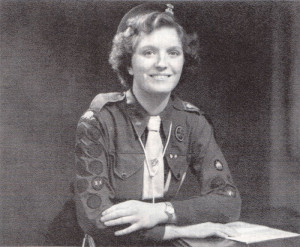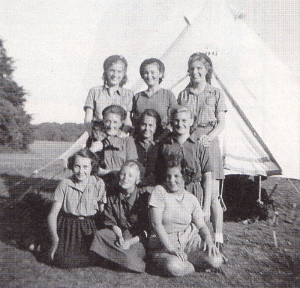
Girl Guiding in the 1940s was very different from what it is today. My Sister and I joined our nearest company at St. Mary’s Mission in Fratton Road, Portsmouth, on our 11th birthday in 1944. I remember the hall being poorly-lit and extremely cold in winter, but we loved it.
We met at 7.30pm every Monday evening. On the dot, our Captain would call: “Guides, fall in!” We were then ready for our weekly inspection. Our hair, if long, had to be kept off our collars with either navy or black ribbon, fingernails had to be clean, and once we’d enrolled and been presented with our badges, these had to be cleaned with Brasso back and front. Even the pins had to be polished until they shone. Our aim was to polish our badges until they were so smooth they looked old, but even after hours of elbow grease, this rarely happened.
Younger people today might also be surprised to learn that when our shoes were being inspected, we had to lift each foot off the floor to show that not only had we polished the uppers, but also the section between the sole and heel. There were no trainers in those days!
In wartime, uniforms were passed down by the Captain, and if the dress was too short we wore our navy school skirts over the top, making the top into a blouse. Our ties were saxe blue and, when unfolded, triangular in shape. We then folded them in the correct way and made sure that we tied them with a reef knot and tucked the ends tidily underneath our collars. Woe betide any Guide who tied her tie with a granny knot. Captain had eyes everywhere!
By this time velour hats had been replaced by berets, with our hat badge being positioned slightly to the left. Brown leather belts finished off our uniform with a Girl Guide buckle if you were lucky enough to find one!
After inspection it was time for drill -standing to attention, standing two deep and then standing at ease. Only one girl had to be out of step and we’d have to repeat the whole process until we moved as one. Nobody minded: it was all part of the fun. I must add that we were all very proud of our uniform and made sure we wore it in the correct manner.
After drill we went to our corners for a short period of patrol work. There were
usually five or six Guides in each patrol, including a patrol leader and her second. Patrols were usually named after flowers or birds. I finally became leader of Nightingale Patrol.
Before we could become enrolled we had to learn the Guide promise, law and motto, all of which I have remembered after all these years. At our enrolment ceremony we had to recite these in front of our District Commissioner, Captain and the rest of the company. We were then presented with our much-treasured trefoil badges.
Once enrolled, we were encouraged to work for proficiency badges of our choice. Seven specific badges entitled us to wear the Little House emblem. This was sewn at the top of our right sleeves and other badges were sewn below, as shown in the photograph.
Church parades and Saturday afternoon hikes took place throughout the year. In winter we played indoor games to help keep warm, and at the end of each evening we ended our meeting by singing TAPS.
“Day is done, gone the sun, from the hills, from the sea, from the sky, all is well, safely rest, God is nigh”.
As the evenings became warmer, before TAPS we would often sit on the floor singing camp fire songs which we all enjoyed. On fine summer evenings we sometimes met on Southsea Common to play either rounders or stool ball.
After the war, summer camps were popular. Usually these were less than ten miles from home, although we all thought it was a lot further. It was great fun camping in farmers’ fields, and even plodding around in mud ankle-deep didn’t stop us enjoying ourselves. We used ex-Army bell tents, all sleeping around the tent pole. In addition to our weekly penny for subs, we paid one shilling per week towards the camp – a lot of money in those days, but it made it easier than having to find the correct amount all at once.

When in August the day finally arrived we met at HQ and loaded our kit bags and haversacks on to the back of a furniture removal van. There was always a lot of excitement and laughter as we jumped on the back and sat on the floor of the van, waving to passers-by. On one occasion our homeward journey along London Road at North End, we sang the camp fire song Donkey Riding. When we reached the verse: “Were you ever in Cardiff Bay, where the folks all shout HOORAY! ” we really let rip, much to the surprise of the Saturday afternoon shoppers. I still have my exercise book in which I wrote lots of our favourite camp fire songs.
While on holiday in Canada with my husband a few years ago, I was very much reminded of: “Land of the silver birch, home of the beaver, where still the mighty moose meanders at will”. It all rang true – lots of spectacular scenery and lovely animals which roam around even in the towns.
After leaving school some of us began our training to become State Registered Nurses at St. Mary’s Hospital. Our off-duty rotas varied, and it wasn’t always possible to have a regular evening off each week. By this time I believe St. Mary’s Mission had closed, and as a result some of us helped with a Copnor Guide company. We taught first aid and helped girls prepare for their proficiency badges, but as our training progressed, having to work a 48-hour week, studying and preparing for examinations, we were no longer able to continue.
I hope I have carried our guide law, promise and motto with us throughout our lives. Looking back, it was an experience I wouldn’t have missed for the world.
I believe I put my Guide training into use last year. I’m now a member of Hamble Lifeboa t Guild, and a friend and I found that no transport was available to take us and our sales items home from an event in the Royal Victoria Country Park.
My husband was unable to locate us, and the duty ranger had locked the only telephone kiosk and gone home. After trying to think of a solution I decided that, as we were returning the following morning, we’d hide non-lifeboat items in the undergrowth under the trees. We made sure everything was out of sight and hoped there would be no rain. It was with some trepidation that we returned the following morning, but we needn’t have worried: everything was just as we’d left it and we were able to set up our stall again and had a very successful day.
Needless to say, we both heaved a big sigh of relief.
Mary Woods.








